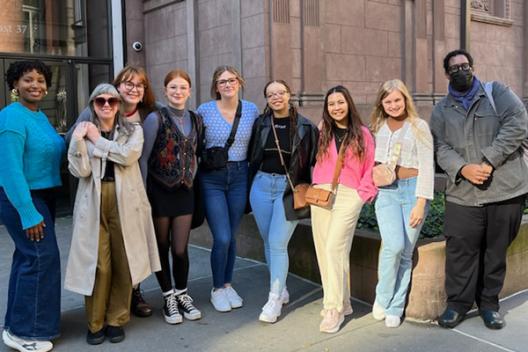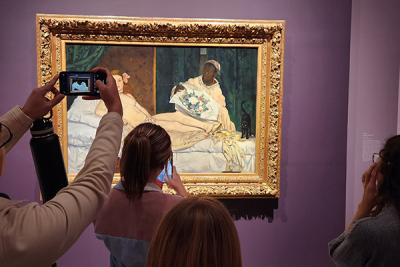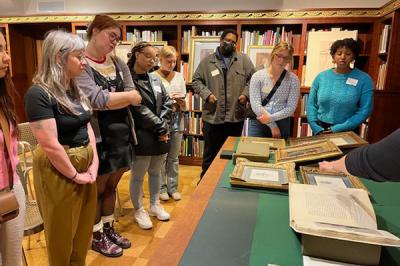
The History of Art Department organized another undergraduate student trip to New York City to accompany the capstone research seminar, taught this year by Professor Andrew Shelton. His course was thoughtfully designed around the Manet/Degas exhibition at the Metropolitan Museum of Art, which examines the overlapping, yet diverging, artistic careers and objectives of Édouard Manet and Edgar Degas.
When we arrived in New York on Thursday morning, the first day of autumn break, we had already learned so much about Manet and Degas that we could not wait to see their work in person. Luckily, our first and only stop of the day was a trip to the Met. We traveled together by subway and lingered in the 19th and early 20th century European galleries while waiting for our turn to enter the special exhibition. There were so many works that we had read about hanging in these galleries; we saw the works of painters who had served as inspiration to Manet and Degas, such as Gustave Courbet or Jean- Auguste-Dominique Ingres, as well as the works of academic artists used as counterpoints in our readings, such as Jean-Léon Gérôme and Alexandre Cabanel. And once inside the Manet/Degas exhibition, we were

once again bombarded by so many incredible works. Manet’s Olympia, which rarely travels outside Paris, was a favorite to gather around and discuss, while Degas’ The Bellini Family was surprisingly large and absolutely mesmerizing. We each spent time looking closely at the artwork we had chosen for our research papers, diligently taking notes, before traveling back to the hotel together. That evening, some of us attended an optional lecture at the MoMA titled Black Curators Matter: An Oral History Project, while others stayed at the hotel to catch up on rest.

Friday morning after breakfast, we walked to the Morgan Library and Museum where we met with Jennifer Tonkovich, the curator of drawings and prints. She had graciously prepared a presentation for our class and pulled their collection of Degas drawings for us to view. Tonkovich guided us through the worked and re-worked drawings, asking us to find the areas that gave Degas the most trouble. She explained that it was here, in these areas of trouble and focus, that we could see what was most important to Degas. We were then shown a personal sketchbook of Degas’, in which there were hundreds of studies, sketches, notes and caricatures. And last, as a nod to Manet’s place in our course, Tonkovich unveiled their copy of Le Corbeau, a translation of Poe’s “The Raven” by Stéphane Mallarmé and illustrated by Édouard Manet.

After lunch, we met at MoMA with Ohio State history of art alumna Adelia Gregory, who now works as their Associate Educator of Public Programs and Galleries Initiatives. She talked with us about her work at MoMA, her career path, which included time at the Wexner Center for the Arts, and answered questions about the desired experience for museum industry hires (spoiler: it’s customer service); and we ended the day wandering through MoMA’s incredible collection of art.
On Saturday, our last full day in New York, we visited the Guggenheim Museum before heading to the Met for one final look at Manet/Degas. This time, Professor Shelton met with each of us about our chosen artwork and we discussed possible directions for further research. Before leaving, we explored the rest of the Met’s collection, which spans the globe and thousands of years of history.
Sunday, we packed up our things and left New York. We were so tired yet so appreciative of this amazing opportunity where we could learn more about the art world, the many careers it offers, and to see so much art with new friends.
Dani Kissinger
History of Art Major
